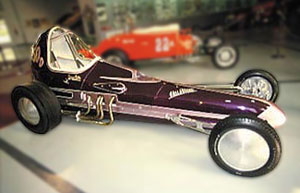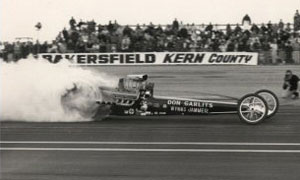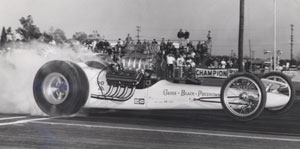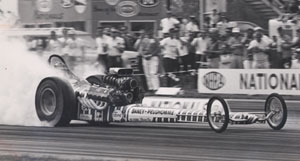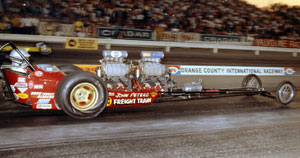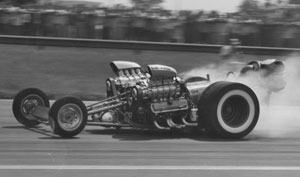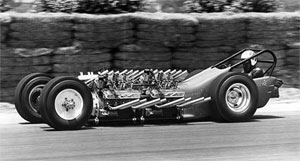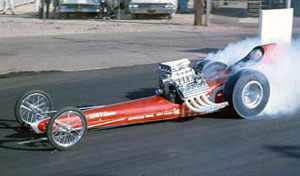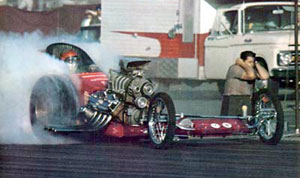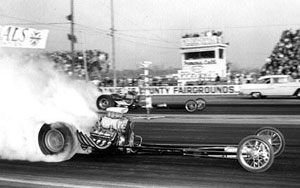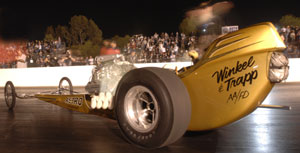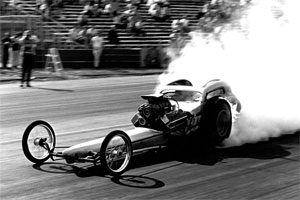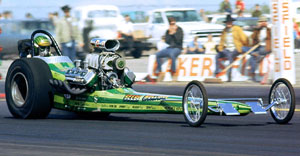

Favorite Race Car Ever voting: Early Dragsters
|
|
||
|
|
||
|
|
||
|
|
||
|
|
||
|
|
||
|
|
||
|
|
||
| Final results for all-time favorite Early Dragster | ||
| The Freight Train |
725
|
(19.02%) |
| Beebe & Mulligan’s Fighting Irish |
639
|
(16.76%) |
| Don Garlits’ Swamp Rat VI |
447
|
(11.73%) |
| Greer-Black-Prudhomme |
433
|
(11.36%) |
| Tommy Ivo’s Showboat |
294
|
(7.71%) |
| The Surfers |
251
|
(6.58%) |
| Don Garlits’ Swamp Rat I |
239
|
(6.27%) |
| Eddie Hill’s Double Dragon |
207
|
(5.43%) |
| Flamin’ Frank Pedregon’s Fiat |
133
|
(3.49%) |
| Baney-Pink-Prudhomme |
95
|
(2.49%) |
| The Frantic Four |
94
|
(2.47%) |
| Speed Sport Roadster |
91
|
(2.39%) |
| Arfons Bros. Green Monster |
61
|
(1.60%) |
| The Glass Slipper |
41
|
(1.08%) |
| Stellings and Hampshire |
39
|
(1.02%) |
| Winkle & Trapp MagiCar |
23
|
(0.60%) |
|
Total Votes: 3812
|
||
|
|
||
|
|
||
|
|
||
|
|
||
|
|
||
|
|
||
|
|
||
|
|
||
Okay, race fans, here’s where the going gets even tougher. I've given you a couple of warm-up polls and now comes probably your toughest decision since deciding which "lucky" socks to wear to the prom.
I’d wager that a fair portion of the regular readers of this column got their introduction to the sport courtesy of front-engine Top Fuelers and Top Gassers and that many of those early machines still hold a fond spot in your hearts. Looking over the list of nominees, there isn’t a weak dog in the batch; all are truly memorable, wonderful machines from an amazing era in our sport, and, luckily for today’s fans, many have been re-created so that they can once again be ogled.
So, in no particular order, here are the entrants in the Early Dragsters portion of our Favorite Race Car Ever poll. Pick wisely -- you only get one vote!
Perhaps one of the sport’s earliest streamliners is the fabulous Glass Slipper entry of Ed and Roy Cortopassi and Doug Butler. Built in 1954, its streamlined fiberglass body and enclosed canopy was a head-turner wherever it went and was named
Although memorable in its design to anyone who saw it run, anyone who ever heard the Speed Sport Roadster run will never forget it, either. Dubbed "Ol' Noisy" due to a unique exhaust system that channeled eight open pipes underneath the body, the Tucson, Ariz.-based car, campaigned by "Red" Greth, Lyle Fisher, Joe Bush, and the late Don Maynard, was a true crowd-pleaser. With a unique rear-engine shape that sandwiched a '23-T Ford body between a fiberglass nose and rear canopy that hid a carbureted Hemi cackling 100 percent nitro, the car ran 160.14 mph at the 1957 ATAA World Series to set a world record and ran as fast as 169 mph later that year. The car was retired in 1958 and a newer version built, but the original is still revered by fans everywhere.
The Arfons brothers campaigned a lot of cars in their time, from early dragsters to land-speed cars, but the cars on this list are their early Allison-powered Green Monster dragsters. Their first race car, so the story goes, was a six-cylinder-powered three-wheeler with an ugly green paint job that the announcer at their local track began referring to as a “green monster,” and the name stuck. The brothers experimented with the Allison engines, piston-powered, 2,000-horsepower monsters originally used in fighter planes, due to their post-war abundance, cheapness, and reliability, and their Green Monster 6 was the first to exceed 150 mph at the 1956 Nationals in
More than 30 versions of this next car have been built, but for some fans, it’s the original that sticks out the most. Swamp Rat I, built in the mid-1950s in a home garage by a young Floridian named Don Garlits, launched him on his path to fame and glory. Garlits was setting records and winning with this car almost from the start, running 176.4 mph in November 1958 in Brooksville, Fla., and he later was the first to exceed 180 mph with an eight-Stromberg carbureted 454-cid Chrysler engine. Garlits eventually traveled west with this car, winning a big meet in
Recalls reader William Tickle, “As a 14-year-old kid just getting interested in cars, I was wondering what all the guys in high school were talking about when they were discussing drag racing and in particular a Mr. Donald G. Garlits. ‘What did he run? How fast did he go?’ One day I noticed a cardboard sign tacked to a phone pole in our neighborhood advertising said Mr. Garlits appearing at Golden Triangle Drag Strip in
Not surprisingly, Garlits has multiple cars on the list; the second is Swamp Rat VI, the 392-powered Wynn’s Winder that was the first car to top 200 mph, at Island Dragway in New Jersey in 1964, and the car with which later that year he won his first of eight U.S. Nationals titles. Lifelong Floridian Jim Hill was there and among those who nominated this car.
“In late August 1964, I finagled my way into ditching the start of my senior year in high school at Hialeah High, in
The week started with NHRA’s official tech inspections. In those days, tech was held in the parking lot of the shopping center at the corner of
“Qualifying and class runoffs were nothing short of incredible, beginning with the first pair of cars at 8 a.m. to the last pair at 6 p.m. It was wall-to-wall, back-to-back drag racing action featuring a never-ending variety of race cars!
"For the first time in many years, nitro fuel dragsters were again welcomed at the Nationals. There was a dizzying turnout, and all the 'names' were there ... Garlits, The Hawaiian, Prudhomme, Ivo, Ongais, The Guzler, Frantic Four, ‘Sneaky Pete’ Robinson, Eddie Hill, Joe Schubeck, Crossley-Williams-Swan, Tom Hoover, The Ramchargers, Connie Swingle, Logghe Bros., Dick Vest, Gordon Collett, Connie Kalitta, and so many more. On Sunday, the fuelers ran round after round for the AA/FD class trophy and the chance to sit out until the final round, and all e.t.s counted as qualifying numbers. On Monday, Garlits was the man, the first Top Fuel winner at the IRP-hosted Nationals.
“In winning Top Fuel, Garlits was awarded a set of Craftsman tools, a few other merchandise awards (I seem to remember a Sturdevant torque wrench, a P&G valve gapper, and a few other trinkets), and, of course, the Nationals Top Eliminator trophy. He had other race dates to keep, so we volunteered to bring home to
“With that said, my all-time favorite has got to be that long, black 392 Hemi-powered Wynn’s Jammer, the one, true icon of Don Garlits’ lengthy, storied drag racing career. To this day, whenever I see a photo of that car, my memory eases me back to those days and the1964 NHRA Nationals.”
If Garlits can have two cars on the list, it’s only fair that drag racing’s other great Don, Don “the Snake" Prudhomme, would have two as well.
Arguably the car that made Prudhomme a star was the fabled Greer-Black-Prudhomme Top Fueler. The short-wheelbased yellow killer, built by Kent Fuller for Tommy Greer and tuned by the legendary Keith Black, racked up a reported (and relatively undocumented) 236-7 win-loss record from June 17, 1962, through the end of the 1964 season, primarily at Lions but also up and down the West Coast and even in occasional forays across the nation. Just based on the info that is available, the car won well over 90 percent of its head-to-head races. With high sevens at 190 mph, it was the dominant car in those years and provided a perfect résumé that catapulted Prudhomme into the saddle of Roland Leong’s Hawaiian in 1965.
After leaving Leong at the end of 1965 and going it alone for a year, Prudhomme teamed with Lou Baney on a very successful Ed Pink-tuned Top Fueler that’s the second of his cars on the ballot, the Baney & Prudhomme SOHC Ford-powered dragster that not only won the 1967 Springnationals in Bristol, Tenn., but also recorded the class’ first six-second run in national event competition, a first-round 6.99 that he later bettered with a 6.92 in the final. He also came within one round of winning his first world championship that year but lost in the final in
What can be said about the next entry that I haven’t already said in a number of my columns published in May? The John Peters & Nye Frank dual-engine Freight Train Top Gasser was an iconic car of drag racing’s 1960s that ran as hard and as often as any car could be expected and won most of the time.
Arthur Trim, like many Train buffs, is vocal in his support. “Hands down, easiest answer to your question: the most all-time favorite, most-bad-ass, go-get-'em, run-what-you-brung, drag race car ever is the Freight Train! John Peters, almost by accident, worked very hard to be competitive wherever, whenever he unloaded his racer. John also had the knack of picking the right driver. Considering all of the phases and modifications, clutches, tires, engine locations, wheelbase length, blower drives, engine couplings, and on and on. The Train was always competitive out of the box, off the trailer, always!”
Next on the multi-engine hot parade is the twin-engined, dual-rear-tired Double Dragon dragster of “the Texan,” Eddie Hill, whose tires literally dug holes in the starting line at the 1961 NHRA Nationals in
If two is good, then four must be better, right? “T.V. Tommy” Ivo once called his four-engined, four-wheel-drive Showboat dragster, which debuted in 1960, “the car that really made my career.” Although the car, powered by a quadruple-header of injected Buick engines, finished its life as an exhibition car clad in a station wagon body, Ivo initially built the car as a serious race car. Instantaneous four-wheel smoke and speeds of 170 mph made it a crowd-pleaser, win or lose. There’s some great footage of the car in action here, with Ivo explaining how the car worked (the two right engines, joined at the crankshafts, drove the rear wheels; the left engines, mounted backward in the chassis, drove the front wheels through a reverse ring and pinion … genius!).
Reader Mike Bockius remembers Ivo’s car well, “its four drag slicks smoking up everything so bad that you couldn't see anything.”
Another of the symbolic West Coast Top Fuelers of the early 1960s, the Stellings & Hampshire entry was also built by the era’s master, Fuller, for Larry Stellings and driver Jeep Hampshire. The beautiful full-bodied candy-red and metal-flake-silver car was one of the region’s strongest in 1963-64, running down into the 7.60s, and was the epitome of what a fuel dragster should look like in those times. The car also was featured in the 1964 Annette Funicello/Frankie Avalon film
Wrote Mark Wales, “My favorite car for not only its performance but also for its ‘drop-dead’ looks is the Stellings & Hampshire beauty. The bodywork was perfect, with lines that defined the ultimate design for a Top Fueler for many years to come, plus the thing ran like gangbusters, setting several track records for e.t. and speed. It had a distinctive deep-throated sound out of the trusty 354 Chrysler engine that told you that it not only had the pretty looks, but that they also meant business.”
Back in the day, a couple of pals could pool their resources, their skills, and their wiles and have a pretty successful Top Fuel operation, which is exactly the case of the famed “Frantic Four” – Norm Weekly, Ron Rivero, Jim Fox, and Dennis Holding – who fielded one of the most popular Top Fuelers of the early to mid-1960s. Their small-block Chrysler-powered dragster, with “Stormin’ Norman” at the wheel, set track records up and down the West Cast and made them a household name among drag racing aficionados.
Offered Terry Spencer, “My number-one favorite car, for sentimental reasons, was the Frantic Four dragster with the ‘little’ 354 motor, running against all the 392s of the day and beating most of them. The most glorious day for me and this car came at
A lot of cars got a lot of nominations, but no car/team seemed to have as many reasons supplied by the nominator than that of the popular Surfers Top Fuel team of Tom Jobe, Robert Skinner, and wheelman Mike Sorokin. The trio, who ran on a shoestring budget and built their first car to a wheelbase that had to fit into the garage where they quartered the car at Skinner’s mother’s hotel, were always a handful at SoCal tracks on a weekly basis from 1963 through 1966 and won major meets such as the 1966 March Meet and Fontana’s 200-mph Club event. The team split up after the 1966 season, and Sorokin was killed the following year while driving for another team.
“Three guys having a great time and winning against much bigger names,” summarized Wayne Brunmier. “It might not have been pretty, but when Surfers fired up, running near 100 percent nitro – that sound, the smell of nitro – you knew it was the Surfers.”
Added Jim Elliott, “If I had to pick just one car, it would have to be the Surfers' Top Fuel car, not because it was a radical new design or the greatest money could buy. I love that car because it was built and raced by low-dollar guys who did it just to see if they could.”
To which Heath Powell added pointedly, "The baddest and most functional slingshot of its time.”
If you’ve followed the narrative above, you’ve no doubt deduced that Kent Fuller was quite the chassis builder and never lacking for ideas, many of which manifested themselves in the Magicar dragster. A unique ladder-bar arrangement supported the entire drivetrain that, in theory, would better plant the rear end, and a flexible front suspension accommodated for engine torque. Brothers Ron and Dennis Winkel teamed with photographer Kaye Trapp, and veteran wheelman Gary Casaday was tapped as the driver, but the car’s performance proved as inconsistent as the car was beautiful. In 26 events, it had three different drivers – Casady, Jeep Hampshire (the most successful of the trio), and future Top Fuel champ Gerry Glenn – but won just three times and ran mid-sevens at more than 200 mph. Originally painted in gold leaf and then red, it appears regularly at Cacklefest events in its original color.
Speaking of color, there may have been no more colorful character on the early landscape of early dragsters than “Flaming Frank” Pedregon. The father of current nitro Funny Car racers Tony, Cruz, and Frank Jr., his fuel-burning coupe would literally light the rear tires on fire during a run. (Because of its dragster-like extended-wheelbase appearance, I’ve included it here rather than with the door cars/roadsters.) The car was homebuilt yet ran like all get-out, and Pedregon was a great innovator and master showman.
Last and certainly not least is the Fighing Irish Top Fuel dragster of driver John “the Zookeper” Mulligan and partner Tim Beebe. Based on the mutual Irish heritage of the duo and painted with a memorable striped-green scheme, the car was simply one of the quickest cars of the late 1960s. During the 1967 season, they recorded three of the year’s 13 quickest e.t.s, and in 1968, they set low e.t. with regularity and the national speed record at 229.59 mph. They were runner-up at the 1968 Springnationals and, like Prudhomme before them, came within one round and one Bennie Osborn of winning the world championship, setting low e.t. and top speed along the way. Mulligan won his only NHRA national event the next year at the Winternationals. After running a stunning 6.43 during qualifying at that year’s U.S. Nationals, Mulligan’s mount suffered a horrendous top-end fire, and he succumbed two weeks later to his injuries. The loss was felt sportwide and is just another reason why the car is so fondly remembered.
Okay, there’s the list. Get to voting.




















































